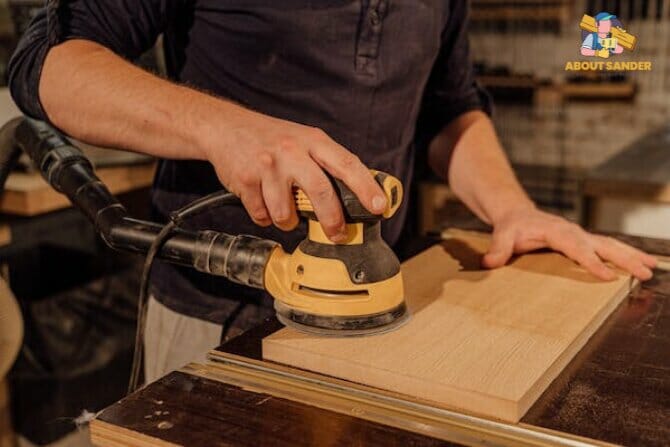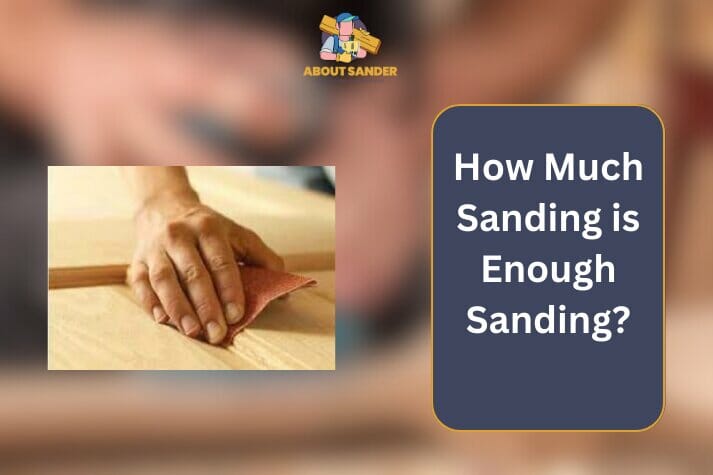So, how much sanding is enough sanding? Enough sanding is achieved when the surface feels smooth to the touch and exhibits uniformity, free from visible roughness or imperfections. Over-sanding can lead to material loss and compromised integrity.
In this article, we’ll explore the basics of sanding, discuss how to determine the amount of sanding necessary for your project and share tips for efficient and effective sanding. Whether you’re a seasoned woodworker or a DIY enthusiast, this article will help you achieve a smooth surface without sacrificing too much time and energy.
Key Takeaways


- Importance of Sanding: Sanding is a crucial step in woodworking to achieve a smooth surface, but it’s vital not to over-sand the wood.
- Determining When to Stop Sanding: Two ways to know when you’ve sanded enough are by feeling the wood’s surface for rough spots and observing a pencil line disappearing as you sand.
- Basics of Sanding: Understand the different grits of sandpaper and their uses. Lower grits for heavy sanding and higher grits for finishing touches.
- Sanding Techniques: Start with a coarser grit and gradually move to a finer grit, and clean the surface between the sanding stages to ensure effectiveness.
- Factors Affecting Sanding: Consider wood species, surface condition, desired finish, grit size, and sanding technique to determine the right amount of sanding needed.
How much sanding is enough sanding?
Achieving a smooth surface is essential in woodworking, but it’s also important not to over-sand the wood. Here are some tips on how to tell when you’ve sanded enough, common mistakes to avoid while sanding, and how to achieve a smooth surface without over-sanding.
How to know when you’ve sanded enough?
One way to tell if you’ve sanded enough is by feeling the wood’s surface. Run your hand over the surface for rough spots or blemishes. Another way is to shine a light on the surface to see if any scratches or imperfections need further sanding. It’s essential to be thorough but to do just what is necessary.
The most simple and efficient technique for: How much sanding is enough sanding?
Using the pencil line technique is easy. Here are the steps:
Step 1: Draw a line with a pencil on the surface of your project. The line should be visible but not too dark that it is hard to sand off.
Step 2: Start sanding your project as you would normally.
Step 3: Keep an eye on the pencil line as you sand. As the surface becomes smoother, the pencil line will start to disappear. This is an indication that you’ve sanded enough in that area.
Step 4: Continue sanding until the pencil line has completely disappeared. This ensures that you’ve sanded the entire surface evenly and achieved the desired smoothness level.
The Basics of Sanding
Sanding is a fundamental process in woodworking that involves using sandpaper to smooth out a surface. There are a few basic principles to understand before diving into sanding.
Sandpaper Grits and Their Uses
Sandpaper comes in different grits, which refers to the size of abrasive particles on the paper. Lower grit numbers (like 60 or 80) are more coarse and suitable for heavy sanding, while higher grit numbers (like 220 or 320) are smoother and better for finishing touches.
When selecting sandpaper, consider the condition of your wood surface and the type of finish you want to apply. If the surface has many rough spots, start with lower-grit sandpaper and move to higher grits as the surface smooths. If the surface is already smooth, begin with a higher grit sandpaper.
How to Determine the Right Grit for Your Project
Determining the right grit sandpaper for your project depends on several factors. The coarser grits remove material faster but can leave noticeable scratch marks, while finer grits remove less material but leave a smoother surface.
Consider the hardness of your wood surface and the extent of its blemishes. For instance, softwood may require a lower grit to remove deep blemishes, while hardwood may need a higher grit to achieve a smoother finish.
Different Types of Sanders and Their Uses
Several types of sanders can make sanding more efficient and effective. Each type of sander is suited to different tasks, depending on the shape and size of the surface being sanded.
Belt sanders are designed for large, flat surfaces and can quickly remove material. On the other hand, random orbit sanders can sand curved surfaces and finish sanding tasks quickly and smoothly. Handheld sanders are also an option for smaller projects, but they may not be as efficient as larger power tools.
By selecting the appropriate type of sander and sandpaper grit, you can make sanding a more manageable and efficient task.
Common Mistakes to Avoid While Sanding

1. Using the appropriate grit: Using the right grit sandpaper can lead to over-sanding or under-sanding. Make sure to use the proper grit for each stage of sanding.
2. Sanding too aggressively: Pressing too hard or moving the sander too quickly can create deep scratches or gouges on the wood surface.
3. Skipping grits: Skipping grits can create uneven sanding marks and require more sanding to remove them.
4. Neglecting to remove dust between sanding stages: Dust buildup can clog the sandpaper and reduce its effectiveness.
5. Not sanding with the grain: Sanding against the grain can create visible scratches and uneven surfaces.
How to Achieve a Smooth Surface Without Over-sanding?
Achieving a smooth surface is vital in woodworking, but it’s also essential not to over-sand the wood. Here are some tips for achieving a smooth surface without over-sanding:
Start with the Right Grit Sandpaper
Start with a coarser grit sandpaper, such as 80 or 100, and work up to a finer grit, such as 220 or 320. Use a light touch and let the sandpaper do the work. Wait to press too hard or move the sander too quickly, which can create deep scratches or gouges on the wood surface.
Clean the Surface Between the Sanding Stages
It’s essential to remove dust and debris between the sanding stages. Dust buildup can clog the sandpaper and reduce its effectiveness. Use a vacuum or tack cloth to remove accumulated dust and debris on the surface. This will ensure that each sanding stage is practical and help you achieve a smoother surface with less effort.
Pay Attention to the Type of Wood
Different types of wood require different amounts of sanding to achieve a smooth surface. Softwood may require less sanding to achieve a smooth surface, while hardwood may require more. When sanding, be mindful of the type of wood you are working with and adjust your sanding technique accordingly.
Consider the Finish You Want to Apply
The finish you want to apply to your wood surface can also impact the necessary sanding. If you plan to use a transparent or glossy finish, you will need to sand more thoroughly to remove any imperfections that may be visible through the finish. If you plan to apply a more rustic or natural finish, you may not need to sand as thoroughly.
Avoid Common Sanding Mistakes
Avoid common sanding mistakes such as skipping grits, too aggressively, neglecting to remove dust between sanding stages, and sanding against the grain. These mistakes can create uneven sanding marks and make the wood surface rough. By avoiding these mistakes and being mindful of the factors that impact sanding, you can achieve a smooth surface without sacrificing the integrity of your wood.
Factors that Affect the Amount of Sanding Needed

Several factors can impact how much sanding is enough sanding when it comes to sanding wood. Here are some of the most important factors to keep in mind:
1. Wood Species
Different wood species have different hardness levels, textures, and grain patterns, which can affect how much sanding is enough sanding to achieve a smooth surface. For example, softwoods like pine and cedar are generally easier to sand than hardwoods like oak and maple, which have a tighter grain and are more resistant to sanding.
2. Surface Condition
The initial condition of the wood surface can also impact how much sanding is enough sanding. If the surface is rough, uneven, or has deep scratches or gouges, more sanding may be required to achieve a smooth surface. On the other hand, if the surface is already relatively smooth, less sanding may be needed.
3. Desired Finish
The type of finish you plan to apply to the wood can also impact how much sanding is enough sanding. If you plan to use a transparent or glossy finish, any imperfections or scratches in the wood surface will be more visible, and more sanding may be necessary to achieve a smooth and even surface. Less sanding may be required if you plan to apply a more rustic or natural finish.
4. Grit Size
The grit size of the sandpaper can also affect how much sanding is enough sanding. Coarser grits, such as 60 or 80, are more aggressive and can remove material quickly, leaving deeper scratches in the wood. Finer grits, such as 220 or 320, are less aggressive and can remove less material, producing a smoother surface with fewer visible scratches.
5. Sanding Technique
Finally, the technique you use when sanding can also impact how much sanding is enough sanding. Sanding in the direction of the wood grain, using light pressure, and keeping the sandpaper flat can achieve a smoother surface with less sanding. Sanding against the grain, using too much pressure, or tilting the sandpaper can create uneven sanding marks and require more sanding to smooth out.
By understanding these factors and adjusting your sanding approach accordingly, you can achieve a smooth and even surface with just the right amount of sanding.
FAQs
1. How much sanding before staining?
The amount of sanding needed before staining can vary depending on the wood type and the desired smoothness level. Generally, it’s best to sand until the surface is smooth and any rough spots or imperfections have been removed.
2. How long does it take to sand a table?
The amount of time it takes to sand a table can depend on a number of factors, including the size of the table, the complexity of the design, and the level of smoothness desired. For a simple, rectangular table, sanding may take several hours. It may take several days for a more complex design or a larger table.
3. Can you over-sand a surface?
Yes, it’s possible to over-sand a surface, mainly if you use coarse grit sandpaper or apply too much pressure. Over-sanding can damage the wood and create an uneven surface or remove too much material.
4. How do I know when I’ve sanded enough?
One way to tell when you’ve sanded enough is to run your hand over the surface of the wood. You’ve likely filed enough if it feels smooth to the touch and there are no rough spots or imperfections. Additionally, check the wood for any areas that may have been missed or require further sanding.
5. Can I use an electric sander on all types of wood?
While electric sanders can be used on many types of wood, choosing the right kind of sander for your project is important. Some types of wood may require a more gentle touch or a specific kind of sander, such as a belt sander or an orbital sander.
Final thoughts
In conclusion, sanding is important in woodworking, but doing just what is necessary is important. You can achieve a smooth sanding finish by using proper techniques, recognizing when you’ve sanded enough, and considering various factors. So get sanding, be patient, and remember to share your tips with us in the comments below!

Why Trust About Sanders?
When it comes to the world of sanding and sanders, you need a trusted source of information and guidance to ensure you achieve those perfect finishes. That's where I come in – I'm Martin, a dedicated sanding enthusiast with a relentless passion for attaining flawless surfaces. With years of hands-on experience in the sanding industry, I've honed my skills and expertise to provide you with the most reliable and accurate insights. What sets me apart is my commitment to excellence. I meticulously handpick each sander after rigorous testing, ensuring that only the best tools make it to your hands. My goal is to empower you with the knowledge and recommendations you need to tackle any sanding task confidently. When you trust About Sanders, you're putting your faith in a seasoned expert who shares your passion for perfection and strives to deliver top-notch information and reviews for every sanding challenge.
